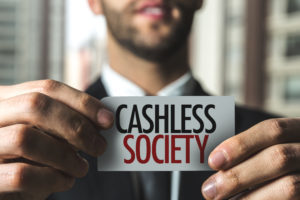The U.S. the IRS has ruled Bitcoins and several of its counterparts are not currencies but, rather a fluctuating investment vehicle that is subject to the capital gain tax. (Photo: iStock)
The continued use of cash is surprising given its inconveniences and the risk consumers face in carrying it around. Love it or hate it, however, cash is playing far less of a role in society and with shooting sports equipment retailers and businesses. With cash rapidly becoming obsolete, welcome to the new cashless world.
Admittedly, many people still do use cash, but with a number of countries working to make payment systems less dependent on cash, many tactical retailers who remain dependent on cash sales are finding income and profits declining. Today, debit cards appear to be the most popular form of payment closely followed by cash and credit cards, with the bulk of payments made by check, money order, prepaid cards, electronic payments and online bill paying.
Retailers and others already have plenty of reasons to eliminate cash employees might steal, or lost to robberies. No one has to count change or make sure a cash drawer balances. Store employees would not have to haul cash to the bank at the end of the day.
The use of credit cards seems harmless, but it comes with a cost — one that retailers tend to pass on to customers. They typically end up raising the prices charged to everyone — including those who pay with cash — to cover the fees that credit card companies charge.
As an alternative to government issued cash, Bitcoin made its first appearance back in 2009 and today there are hundreds of other cryptocurrencies, often referred to as Altcoins. Mainly used for large transactions, in the U.S. the IRS has ruled Bitcoins and several of its counterparts are not currencies but, rather a fluctuating “investment” vehicle that is subject to the capital gain tax.
The Road To Cashless
A Federal Reserve study released earlier this year noted that, since 2000, consumers and businesses have substantially changed their payment choices with check payments primarily being replaced with card payments and electronic transfers.
Not too surprisingly, Governments have been increasingly pushing for a cashless society. Ostensibly, having a paper trail for all transactions would decrease crime, money laundering and tax evasion.
In Germany, strong moves are underway toward limiting cash transactions while Sweden is already far advanced toward a cashless society with many venues prohibiting cash payments for admission. In other ways, Sweden has advanced far along the cashless path as many banks will no longer accept nor dispense cash and where bill and coin transactions now represent only two percent of Swedish commercial activities.
While the elimination of cash is not yet a government policy in Canada, many Canadians are voluntarily moving toward credit and debit card payments with a whopping 77 percent of responders to a recent survey preferring to eliminate cash.
In the Netherlands, cash is definitely not getting the royal treatment. In many places, it has simply ceased to be recognized as legal tender. More and more Dutch stores, from upscale health-food store Marqt to local bakeries and bagel shops, take credit or debit cards exclusively. Some retailers even describe going cash-free as “cleaner” or “safer.”

Many mobile payment systems have been introduced in the past few years including Google Wallet and Apple Pay. Customers with mobile devices have a “digital wallet” option accepted by merchants with NFC terminals up and running. (Photo: iStock)
Hello Plastic, Goodbye ATMs
Illustrating the trend toward a “cashless” world, ATMs may be on borrowed time. According to the Federal Reserve, U.S. banks have been progressively scaling back the number of ATM machines. In 2015, ATM withdrawals dropped by a record 7.2 percent.
Hoping to reverse this trend, customers can use their smartphone devices to pay for goods much like swiping a debit card. Android Pay is looking to change the way users interact with their ATMs by taking plastic debit cards out of the equation.
Android Pay and other mobile wallets now allow users to get cash out of an ATM without having to actually put in a debit card. Instead, users can use their mobile device with Android Pay, tap at the ATM and proceed with the process as usual. No more carrying around a plastic debit card to go to the ATM.
Mobile Payments
Mobile commerce or M-commerce, is the buying and selling of goods and services through wireless, handheld devices such as cellular telephones and personal digital assistants (PDAs) and represented 34 percent of all e-commerce transactions globally last year.
Electronic Money, Mobile Wallets
Electronic money, or e-money, is the money balance recorded electronically on a stored-value card. Electronic money is a floating claim on a bank or other financial institution that is not linked to any particular account. Examples of electronic money are electronic fund transfers, direct deposits, payment processors and, of course, digital currencies.
Although the digital era has been in full swing for some time, many retailers have yet to invest in the latest technology. Near field communications or NFC is one such technology shooting sports equipment retailers might want to consider as part of their marketing campaign.
Many mobile payment systems have been introduced in the past few years including Google Wallet and Apple Pay. Customers with mobile devices have a “digital wallet” option (a list that’s ever-growing) accepted by merchants with NFC terminals up and running.
According to many reports, Wells Fargo Bank will soon launch an NFC-based mobile payment service. With mobile wallets, such as the one Wells Fargo plans, customers enter their credit card information in their phones before shopping with merchants who use NFC technology. The customer holds the phone over a payment terminal and taps a button on the phone or enters a PIN.
Another benefit of the new NFC technology is the possibility of integration with social media. Imagine, with a quick scan, customers can automatically alert followers of their location — your store — along with an invitation to join them. A retailer or business can achieve similar results by setting an NFC tag by the store’s entrance. A friend or "like" request for your operation’s webpage will automatically be sent to customers with an NFC-enabled phone as they enter the premises.

Many people still do use cash, but with a number of countries working to make payment systems less dependent on cash, many tactical retailers who remain dependent on cash sales are finding income and profits declining. (Photo: iStock)
Necessary Security
Along with the convenience offered by cashless transactions is an increased awareness of security concerns. A good example is provided by the new chip encoded “smart” cards that an estimated 90 percent of consumers will soon have.
By now, every business owner and manager should be aware of the so-called “liability shift” that occurred when the new EMV (Europay, MasterCard & Visa) technology was introduced. No longer will the credit card companies be liable for fraudulent use of the old credit card technology. In essence, businesses such as firearms retailers and card processors who continue to use the old technology will find themselves, not the credit card companies, liable for fraud.
Admittedly, finding a suitable approach for transitioning from conventional credit cards to the new EMV smart card technology has been difficult. Fortunately, there is good news for merchants in that true integrated solutions have recently been introduced. These new tools are cutting edge implementation of technology that takes a store’s current POS system data and migrates the communication with a chip processing device. This streamlined process meets regulations, consumer demand and the bottom-line concerns of merchants.
Give ’Em What They Want
Adopting any of these new and emerging payment systems largely depends on what the store’s customers prefer and are willing to deal with. In other words, will the customers of the tactical firearms and equipment business embrace or reject these new payment options?
Surprisingly, around 8 percent of the U.S. population remains “unbanked,” and 20 percent of households are underbanked, meaning that "they have a bank account, but also use alternative financial services (AFS) outside of the banking system," according to a survey by the Federal Deposit Insurance Company.
According to one Gallup poll, 29 percent of Americans don’t have a credit card, a figure that is rising, in part because Millennials don’t like them. The consumer financial services company, Bankrate, recently published figures that put the number of Millennials without a "major" credit card at a staggering 63 percent. The main alternative are prepaid cards, but they are burdened by high fees.
The differences between the worldwide trend and that of U.S. consumers may be explained by the fact that younger consumers apparently buy different products and services, patronizing different venues than older individuals. All of which raises the question: Does your store offer options to cash that appeal to the groups that constitute the demographics of your store’s customers?
Obviously, there are a great many benefits to removing cash from the economy, but there are also concerns when every single transaction can be monitored, examined or manipulated. However, regardless of where you fall on the debate, one thing is clear: As online shopping becomes yet more prevalent, cash is well on its way to becoming obsolete. Is your shooting sports equipment business really ready for and will it profit in the coming cashless world?
Mark E. Battersby is a freelance writer who has specialized in taxes and finance for the last 25 years. Working from offices in the suburban Philadelphia community of Ardmore, Pa. Battersby currently writes for publications in a variety of fields, syndicates two weekly columns that appear in more than 65 publications and has written four books.





